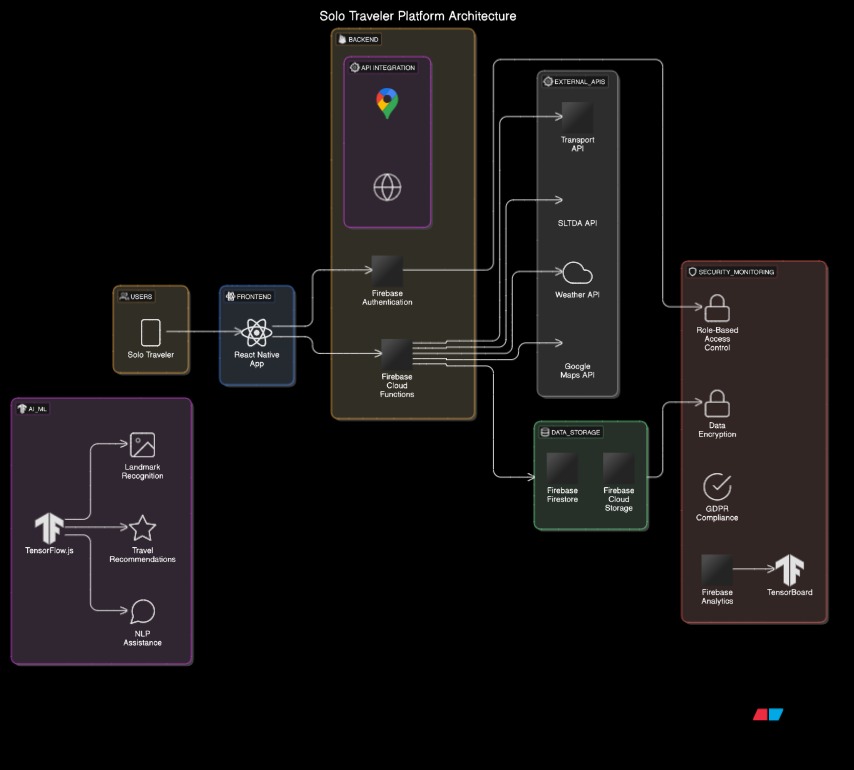
High-Level Architecture Documentation for Solo Traveler Digital Platform
This document provides an overview of the architecture for a scalable, secure, and user-friendly solo traveler platform. It emphasizes efficient data management, seamless user interaction, and robust security measures.
Sections
page 1
page 2
page 1
No description
Table of Contents
Introduction
Purpose and Scope
Key Components
Architecture Diagram
Layer Descriptions
Data Flow Description
Tools and Technologies Used
Risk Analysis
Conclusion
References
1. Introduction
This document outlines the high-level architecture of a digital platform designed for solo travelers visiting Sri Lanka. It ensures user-centric design, scalability, and efficiency through modern technologies.
2. Purpose and Scope
Purpose: To provide a structural overview of the platform’s architecture to guide its development and deployment.
Scope: Includes user interaction, backend processing, AI/ML integration, external services, and security measures.
3. Key Components
3.1 Users
Solo travelers accessing features like booking, navigation, landmark recognition, and real-time updates on mobile devices.
3.2 Frontend
Developed using React Native with TypeScript, offering real-time UI updates, offline access, and intuitive navigation.
3.3 Backend
Serverless architecture with Firebase for authentication, business logic, and API integrations.
3.4 AI/ML Integration
TensorFlow.js powers image recognition, personalized recommendations, and natural language processing.
3.5 Data Storage
Firebase Firestore for scalable NoSQL databases and Cloud Storage for multimedia content.
3.6 External APIs
Google Maps for navigation, SLTDA APIs for tourism data, and real-time transport/weather APIs.
3.7 Monitoring and Security
Firebase Analytics tracks user behavior, TensorBoard monitors ML models, and Role-Based Access Control ensures security.
4. Architecture Diagram

5. Layer Descriptions
5.1 User Layer
Represents travelers interacting with the platform via mobile devices.
5.2 Presentation Layer
Handles UI/UX with intuitive navigation and real-time updates.
5.3 Business Logic Layer
Executes application logic on Firebase and integrates external services.
5.4 AI/ML Layer
Provides AI/ML-driven features for real-time image recognition and personalized suggestions.
5.5 Data Layer
Stores structured and unstructured data using Firestore and Cloud Storage.
5.6 Integration Layer
Connects the platform with Google Maps, SLTDA, and other APIs.
5.7 Security Layer
Ensures secure data interactions and privacy compliance.
6. Data Flow Description
Users interact with the mobile app.
Data flows from the frontend to the backend via Firebase Cloud Functions.
Backend processes requests, integrates AI/ML models, and fetches data from APIs.
Results are stored in Firestore or sent back to users.
Monitoring tools track performance and usage metrics.
7. Tools and Technologies Used
Component | Technology/Tool |
|---|---|
Frontend | React Native, TypeScript |
Backend | Firebase |
AI/ML | TensorFlow.js |
External APIs | Google Maps, SLTDA APIs |
Database | Firebase Firestore |
Monitoring | Firebase Analytics, TensorBoard |
Security | RBAC, GDPR compliance |
8. Risk Analysis
Integration Risks
Mitigated through compatibility testing and modular development.
Performance Risks
Handled using scalable cloud infrastructure and caching.
Security Risks
Managed with encryption, audits, and GDPR compliance.
User Adoption Risks
Addressed by intuitive design and onboarding tutorials.
9. Conclusion
This document provides an overview of the architecture for a scalable, secure, and user-friendly solo traveler platform. It emphasizes efficient data management, seamless user interaction, and robust security measures.
10. References
Firebase Documentation.
TensorFlow.js Tutorials.
Google Maps API Documentation.
SLTDA Tourism Data Resources.
0 / 300